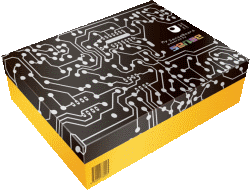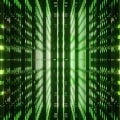 Mike Richards, Open University
Mike Richards, Open University
Thursday 14th June 2012 – 7:30pm
Oxford e-Research Centre, 6 Keble Road, Oxford, OX1 3QG
This future was conceived by Mark Weiser, chief scientist at Xerox PARC – where the PC was invented. In 1991, writing in Scientific American, he described a future where computers and data had merged seamlessly with the environment, and gave it a name – ubiquitous computing. Weiser’s realisation was that Moore’s Law inevitably meant computers would continue to become cheaper. We wouldn’t just own one computer, we would own, or interact with tens, hundreds, even thousands of them. The cost of adding a computer to a manufactured object would be far outweighed by the benefits it brought. In time, almost any manufactured object would contain a computer. The computer as a discrete, utilitarian box would disappear, instead it would come in an unimaginable number of shapes and forms, from smartphones to game consoles, domestic appliances to cars, even embedded in the infrastructure of our buildings and cities.
The ubicomp revolution forecast twenty years ago is quietly emerging all around us. It comes from any number of places – well-established companies, novel start-ups and universities. It is chaotic and exciting, and it is developing at incredible speed. The ubicomp world is becoming real whether we want it or not. Are we prepared for it? We will engage with new technology seeing its benefits, or will we recoil, terrified of the threats? Can we make the considered judgements needed to say what is, and what is not acceptable in a democratic society? Experience suggests that novel technologies, such as nuclear power and genetic modification are initially welcomed by society; but go on to engender distrust, even hatred. Areas of science and engineering can no longer be discussed in rational terms such are the emotions they bring with them. We cannot risk ubicomp following this path.
Now is the time to have an open and frank conversation to which everyone, not just those in the technology sector, is invited. We need to discuss how we build the best possible future based on technology, but not enslaved to it, a future where individual liberty and that of wider society are protected and enhanced by sensitive and appropriate uses of digital technology. A future where the next five billion people who have never used the Internet are welcome and bring their imagination and potential.
So we’ve made a start.
 We think the best way to understand the future is to build it.
We think the best way to understand the future is to build it.
Over the last few years we have designed and built hardware and software that allows novice learners to explore ubiquitous computing. We call our hardware the SenseBoard; a simple ubiquitous computing laboratory that fits in the palm of your hand. A SenseBoard contains a number of sensors, some programmable lights and a few controls. But you can make it do more, by plugging in motors or additional sensors which are supplied along with the board. Our software, Sense, lets beginners design sophisticated projects without having to learn complex programming languages.
More than 4,500 students have already begun exploring ubiquitous computing; creating their own projects and sharing their findings with one another. We have challenged them to answer questions such as: Who owns your data? Where is it stored? How is it used? Can I opt out? Can it be switched off? Who is in control? And what if it all goes wrong?
Event Information
The meeting is on Thursday 14 June, 7.00 for 7.30 and ends around 9.00.
It will be held at the Oxford e-Research Centre, 6 Keble Road, Oxford OX1 3QG.
Sandwiches and light refreshments are available from 7.00pm.
Meetings are open to non-members and free.





